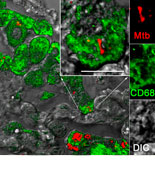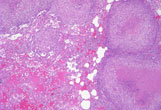 |
  DISEASES WE INVESTIGATE DISEASES WE INVESTIGATE
Tuberculosis
Overview
Tuberculosis (TB) is a life threatening and debilitating disease transmitted through the air from person-to-person by breathing in bacteria called Mycobacterium tuberculosis.
- It is estimated that 1.7 billion people (one third of the world population) harbor latent TB infections, and 5-10% of them carry a lifetime risk of reactivating their disease.
- In the U.S., tuberculosis began to disappear after several effective drugs were developed in the 1940’s. Although there was a temporary increase in TB during the 1985-1992 AIDS epidemic, today about 16,000 annual cases are reported.
- TB develops in patients who have an immune system that cannot stop the growth of the bacteria. Babies and young children are at risk before their immune system is fully developed. People with HIV infection (AIDS) have very weak immune systems, as do patients with drug abuse problems, diabetes, silicosis, cancer, kidney disease, low body weight, and those undergoing systemic corticosteroid treatment or organ transplants.
- TB is a common disease in most countries of Latin America and in the Caribbean, Africa, Asia, Eastern Europe, and Russia.
Infectious Agent
- TB is caused by Mycobacterium tuberculosis, a single-cell, membrane-bound, microscopic organism with ability to replicate within cells of the patient and induce disease.
- The bacterium can attack any part of the body, but the lungs are usually affected.
- Mycobacterium tuberculosis is the most common organism infecting humans, but Mycobacterium bovis, which infects animals, produces an indistinguishable infection in humans. Numerous closely related strains of these organisms can be distinguished by genetic tests.
- Latent tuberculosis is caused by the same organism, Mycobacterium tuberculosis, but the patient’s immune system keeps the growth of the bacteria in check without completely eradicating the infection. People with latent infections do not feel sick and do not have symptoms until their immune system is weakened, allowing the bacteria to grow.
- Multidrug Resistant Tuberculosis is caused by the same organism, M. tuberculosis, but the traditional battery of drugs used against the bacterium is no longer effective. The bacterium acquires this ability through genetic mutation probably caused by inadequate or incomplete therapy. Patients infected with this modified strain of tuberculosis cannot be cured with current drug protocols.
Transmission
- TB is spread through the air when a person with TB lung disease coughs or sneezes. People nearby breath in the bacteria and become infected.
- TB is most likely spread to people with whom a patient has daily contact such as family members, friends, and coworkers.
- People cannot get infected with TB through handshakes, sitting on public toilet seats, or by sharing dishes and utensils with a TB patient.
The Disease
- TB symptoms can vary depending on where in the body TB bacteria are growing. In the lung, TB may cause a bad cough that lasts for more than two weeks, pain in the chest, coughing up blood, weakness, weight loss, no appetite, chills, fever, and night sweats.
- Infection can be detected by skin test and by chest x-ray. Confirmation of TB disease is based on clinical signs, culture of the bacterium, and/or molecular testing for the bacterium.
Treatment
- Effective drugs are available including isoniazid, rifampin, pyrazinamide, ethambutol, and streptomycin. Usually, multiple drugs are prescribed and taken together in a regime that lasts six months to a year.
- Patients with lung infections are usually not infective to others after two weeks of treatment.
- If treatment is not completed or is taken irregularly, the risk of developing a multidrug resistant strain of TB increases significantly.
- In some countries, BCG (a weakened strain of Mycobacterium bovis) is used as a vaccine to prevent TB. Because the vaccine has proven unreliable, it has never been approved for wide scale use in the United States.
Our Research
- We are testing a simpler, more reliable detection system that probes for anti-TB antibodies in blood samples from infected monkeys.
- We are testing a new concept in vaccine technology that combines the molecular backbone of the TB genome with selected molecular elements shown to induce a protective response in patients.

|
 |


